2014 FIAT BRAVO heating
[x] Cancel search: heatingPage 52 of 275
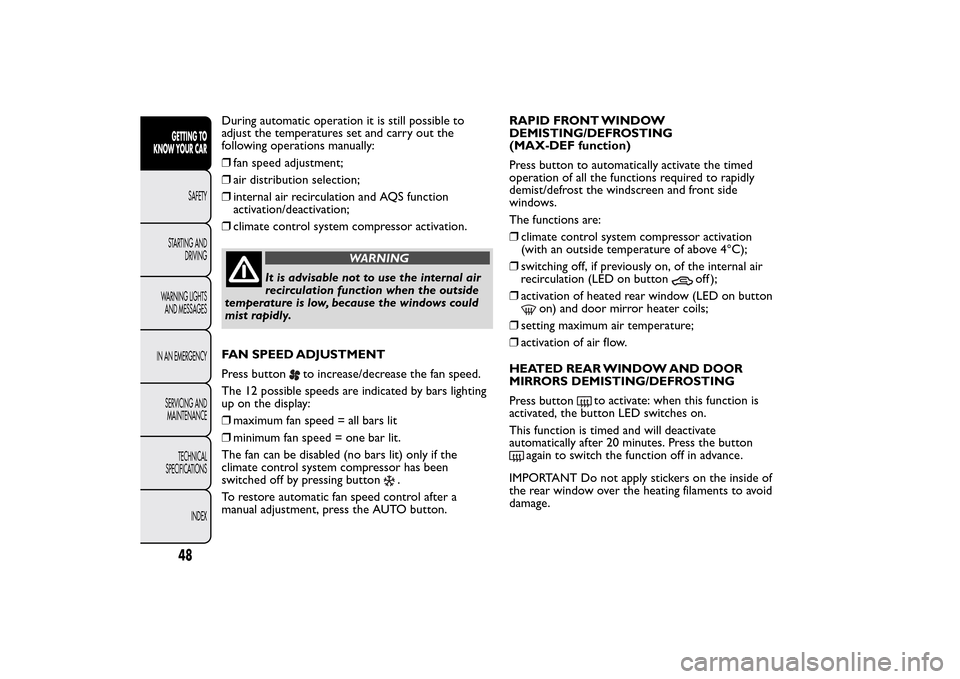
During automatic operation it is still possible to
adjust the temperatures set and carry out the
following operations manually:
❒fan speed adjustment;
❒air distribution selection;
❒internal air recirculation and AQS function
activation/deactivation;
❒climate control system compressor activation.
WARNING
It is advisable not to use the internal air
recirculation function when the outside
temperature is low, because the windows could
mist rapidly.
FAN SPEED ADJUSTMENT
Press button
to increase/decrease the fan speed.
The 12 possible speeds are indicated by bars lighting
up on the display:
❒maximum fan speed = all bars lit
❒minimum fan speed = one bar lit.
The fan can be disabled (no bars lit) only if the
climate control system compressor has been
switched off by pressing button
.
To restore automatic fan speed control after a
manual adjustment, press the AUTO button.RAPID FRONT WINDOW
DEMISTING/DEFROSTING
(MAX-DEF function)
Press button to automatically activate the timed
operation of all the functions required to rapidly
demist/defrost the windscreen and front side
windows.
The functions are:
❒climate control system compressor activation
(with an outside temperature of above 4°C);
❒switching off, if previously on, of the internal air
recirculation (LED on button
off );
❒activation of heated rear window (LED on button
on) and door mirror heater coils;
❒setting maximum air temperature;
❒activation of air flow.
HEATED REAR WINDOW AND DOOR
MIRRORS DEMISTING/DEFROSTING
Press button
to activate: when this function is
activated, the button LED switches on.
This function is timed and will deactivate
automatically after 20 minutes. Press the button
again to switch the function off in advance.
IMPORTANT Do not apply stickers on the inside of
the rear window over the heating filaments to avoid
damage.
48GETTING TO
KNOW YOUR CAR
SAFETY
STARTING AND
DRIVING
WARNING LIGHTS
AND MESSAGES
IN AN EMERGENCY
SERVICING AND
MAINTENANCE
TECHNICAL
SPECIFICATIONS
INDEX
Page 53 of 275
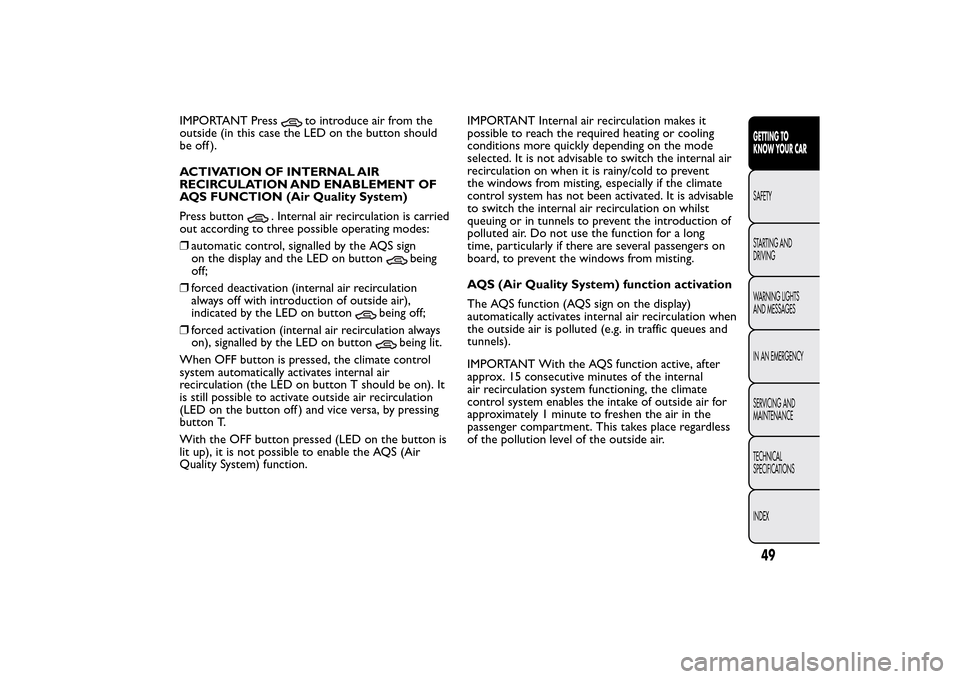
IMPORTANT Press
to introduce air from the
outside (in this case the LED on the button should
be off ).
ACTIVATION OF INTERNAL AIR
RECIRCULATION AND ENABLEMENT OF
AQS FUNCTION (Air Quality System)
Press button
. Internal air recirculation is carried
out according to three possible operating modes:
❒automatic control, signalled by the AQS sign
on the display and the LED on button
being
off;
❒forced deactivation (internal air recirculation
always off with introduction of outside air),
indicated by the LED on button
being off;
❒forced activation (internal air recirculation always
on), signalled by the LED on button
being lit.
When OFF button is pressed, the climate control
system automatically activates internal air
recirculation (the LED on button T should be on). It
is still possible to activate outside air recirculation
(LED on the button off ) and vice versa, by pressing
button T.
With the OFF button pressed (LED on the button is
lit up), it is not possible to enable the AQS (Air
Quality System) function.IMPORTANT Internal air recirculation makes it
possible to reach the required heating or cooling
conditions more quickly depending on the mode
selected. It is not advisable to switch the internal air
recirculation on when it is rainy/cold to prevent
the windows from misting, especially if the climate
control system has not been activated. It is advisable
to switch the internal air recirculation on whilst
queuing or in tunnels to prevent the introduction of
polluted air. Do not use the function for a long
time, particularly if there are several passengers on
board, to prevent the windows from misting.
AQS (Air Quality System) function activation
The AQS function (AQS sign on the display)
automatically activates internal air recirculation when
the outside air is polluted (e.g. in traffic queues and
tunnels).
IMPORTANT With the AQS function active, after
approx. 15 consecutive minutes of the internal
air recirculation system functioning, the climate
control system enables the intake of outside air for
approximately 1 minute to freshen the air in the
passenger compartment. This takes place regardless
of the pollution level of the outside air.
49GETTING TO
KNOW YOUR CARSAFETY
STARTING AND
DRIVING
WARNING LIGHTS
AND MESSAGES
IN AN EMERGENCY
SERVICING AND
MAINTENANCE
TECHNICAL
SPECIFICATIONS
INDEX
Page 103 of 275

IMPORTANT When the SPORT button is pressed,
the function is activated about 5 seconds later.
IMPORTANT During acceleration, when the SPORT
function is used the steering may shudder which is
typical of a sports setting.
IMPORTANT During parking manoeuvres requiring a
lot of steering, the steering may become harder;
this is normal and is due to the intervention of the
system to protect the electric steering motor from
overheating; so, no intervention is required. When
the car is used again later on, the power steering will
work normally.Acceleration
Sudden acceleration has a very negative effect on fuel
consumption and emissions: accelerate gradually to
contain consumption.
When the SPORT function is used the consumption
figures will be slightly higher than those stated.
WARNING
Under no circumstances should
aftermarket operations involving
steering system or steering column
modifications (e.g.: installation of anti-theft
device) be carried out that could badly affect
performance and safety.This also causes the
warranty to become null and void and results in
vehicle non-compliance with type-approval
requirements.
WARNING
Before starting any servicing operation,
stop the engine and remove the key
from the ignition switch to operate the steering
lock, particularly when the wheels do not touch
the ground. If this is not possible (for example
if the key needs to be turned to MAR-ON or
the engine must be running), remove the main
fuse that protects the electric power steering.
99GETTING TO
KNOW YOUR CARSAFETY
STARTING AND
DRIVING
WARNING LIGHTS
AND MESSAGES
IN AN EMERGENCY
SERVICING AND
MAINTENANCE
TECHNICAL
SPECIFICATIONS
INDEX
Page 117 of 275
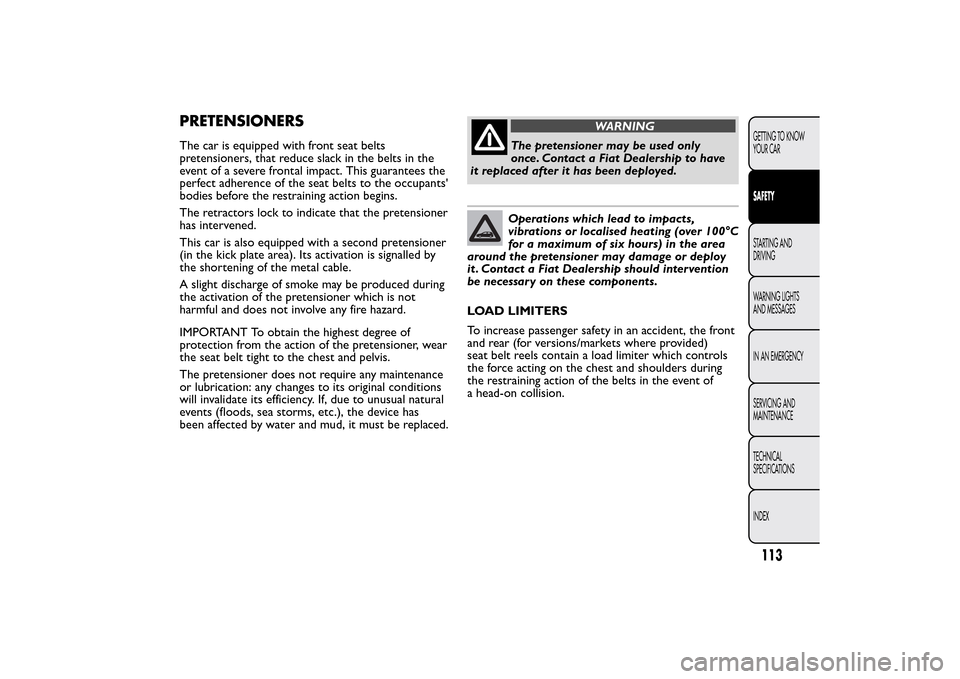
PRETENSIONERSThe car is equipped with front seat belts
pretensioners, that reduce slack in the belts in the
event of a severe frontal impact. This guarantees the
perfect adherence of the seat belts to the occupants'
bodies before the restraining action begins.
The retractors lock to indicate that the pretensioner
has intervened.
This car is also equipped with a second pretensioner
(in the kick plate area). Its activation is signalled by
the shortening of the metal cable.
A slight discharge of smoke may be produced during
the activation of the pretensioner which is not
harmful and does not involve any fire hazard.
IMPORTANT To obtain the highest degree of
protection from the action of the pretensioner, wear
the seat belt tight to the chest and pelvis.
The pretensioner does not require any maintenance
or lubrication: any changes to its original conditions
will invalidate its efficiency. If, due to unusual natural
events (floods, sea storms, etc.), the device has
been affected by water and mud, it must be replaced.
WARNING
The pretensioner may be used only
once. Contact a Fiat Dealership to have
it replaced after it has been deployed.Operations which lead to impacts,
vibrations or localised heating (over 100°C
for a maximum of six hours) in the area
around the pretensioner may damage or deploy
it . Contact a Fiat Dealership should intervention
be necessar y on these components.
LOAD LIMITERS
To increase passenger safety in an accident, the front
and rear (for versions/markets where provided)
seat belt reels contain a load limiter which controls
the force acting on the chest and shoulders during
the restraining action of the belts in the event of
a head-on collision.
113GETTING TO KNOW
YOUR CARSAFETYSTARTING AND
DRIVING
WARNING LIGHTS
AND MESSAGES
IN AN EMERGENCY
SERVICING AND
MAINTENANCE
TECHNICAL
SPECIFICATIONS
INDEX
Page 139 of 275
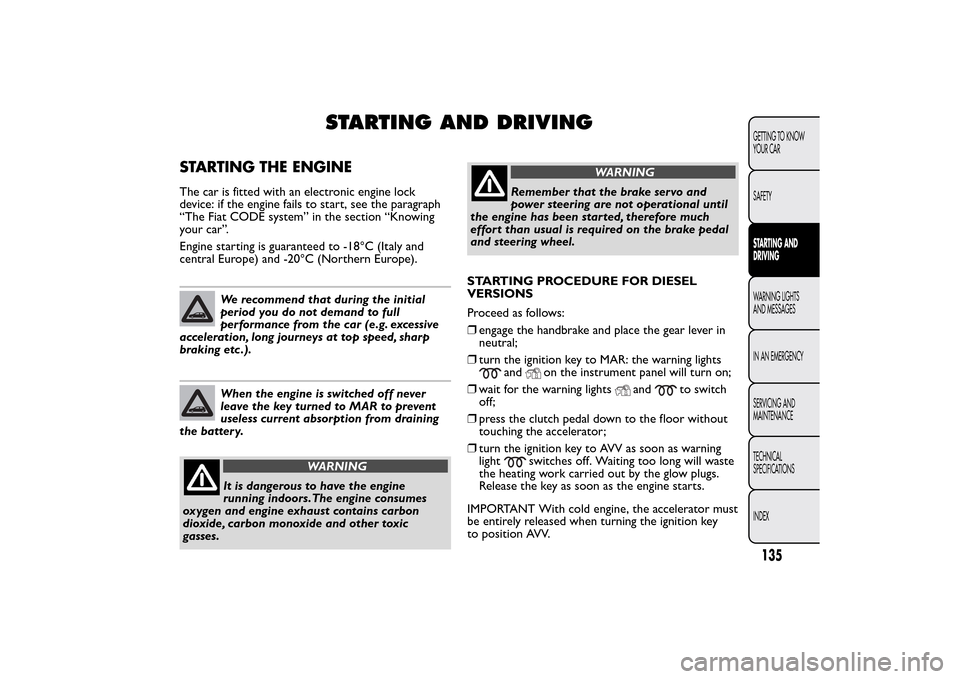
STARTING AND DRIVING
STARTING THE ENGINEThe car is fitted with an electronic engine lock
device: if the engine fails to start, see the paragraph
“The Fiat CODE system” in the section “Knowing
your car”.
Engine starting is guaranteed to -18°C (Italy and
central Europe) and -20°C (Northern Europe).
We recommend that during the initial
period you do not demand to full
performance from the car (e.g. excessive
acceleration, long journeys at top speed, sharp
braking etc .).When the engine is switched off never
leave the key turned to MAR to prevent
useless current absorption from draining
the battery.
WARNING
It is dangerous to have the engine
running indoors.The engine consumes
oxygen and engine exhaust contains carbon
dioxide, carbon monoxide and other toxic
gasses.
WARNING
Remember that the brake servo and
power steering are not operational until
the engine has been started, therefore much
effort than usual is required on the brake pedal
and steering wheel.
STARTING PROCEDURE FOR DIESEL
VERSIONS
Proceed as follows:
❒engage the handbrake and place the gear lever in
neutral;
❒turn the ignition key to MAR: the warning lightsand
on the instrument panel will turn on;
❒wait for the warning lights
and
to switch
off;
❒press the clutch pedal down to the floor without
touching the accelerator;
❒turn the ignition key to AVV as soon as warning
light
switches off. Waiting too long will waste
the heating work carried out by the glow plugs.
Release the key as soon as the engine starts.
IMPORTANT With cold engine, the accelerator must
be entirely released when turning the ignition key
to position AVV.
135GETTING TO KNOW
YOUR CAR
SAFETYSTARTING AND
DRIVINGWARNING LIGHTS
AND MESSAGES
IN AN EMERGENCY
SERVICING AND
MAINTENANCE
TECHNICAL
SPECIFICATIONS
INDEX
Page 140 of 275

If the engine does not start at the first attempt,
return the ignition key to STOP before attempting to
start again.
If, when the ignition key is at MAR-ON the
warning light remains lit, turn the key to STOP
and then back to MAR-ON. If the warning light
remains lit, try with the other keys provided with the
car.
If you still cannot start the engine, contact a Fiat
Dealership.
Warning light
will flash for 60 seconds
after starting or during prolonged
cranking to indicate a fault with the glow
plug heating system.You can use the car as usual
if the engine starts but you should contact a
Fiat Dealership as soon as possible.
When the engine is switched off never
leave the key turned to MAR to prevent
useless current absorption from draining
the battery.
HOW TO WARM UP THE ENGINE AFTER IT
HAS JUST STARTED
Proceed as follows:
❒Drive off slowly, letting the engine turn at medium
revs. Do not accelerate abruptly;
❒Do not demand full performance at first. Wait
until the engine coolant temperature gauge starts
moving.
Never jump start the engine by pushing,
towing or coasting downhill.This could
cause fuel to flow into the catalytic
converter and damage it beyond repair.
EMERGENCY START-UP
Contact a Fiat Dealership if instrument panel
warning light
(or the symbol on the display) stays
on constantly.
STOPPING THE ENGINE
Turn the ignition key to STOP while the engine is
idling.
IMPORTANT After a taxing drive, you should allow
the engine to “catch its breath” before turning it
off by letting it idle to allow the temperature in the
engine compartment to fall.
A quick burst on the accelerator before
stopping the engine serves no practical
purpose; it wastes fuel and is especially
damaging to turbocharged engines.
136GETTING TO KNOW
YOUR CAR
SAFETYSTARTING AND
DRIVINGWARNING LIGHTS
AND MESSAGES
IN AN EMERGENCY
SERVICING AND
MAINTENANCE
TECHNICAL
SPECIFICATIONS
INDEX
Page 158 of 275
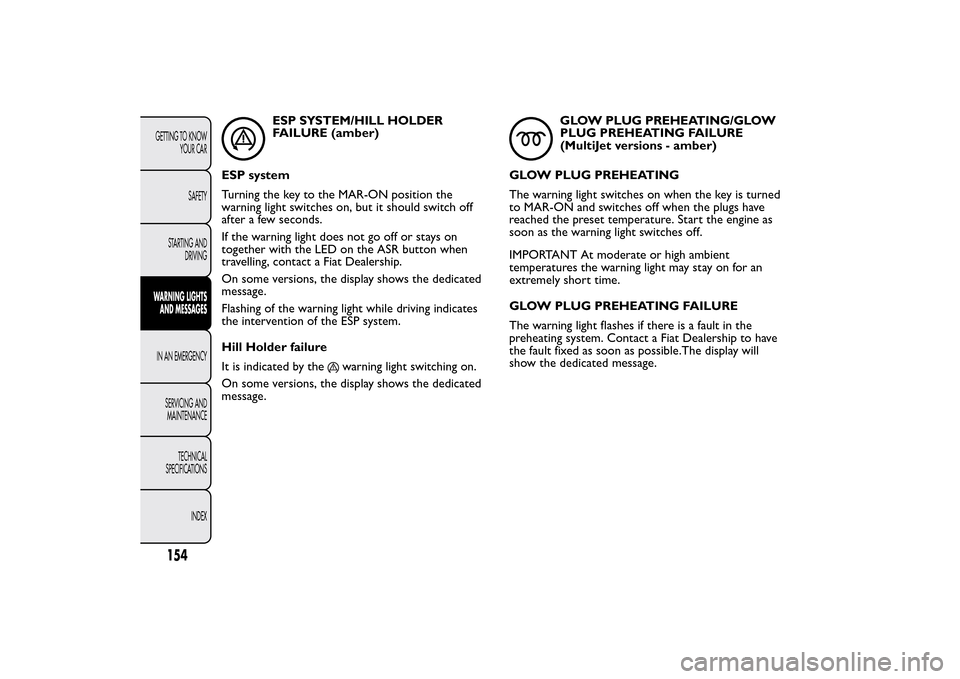
ESP SYSTEM/HILL HOLDER
FAILURE (amber)
ESP system
Turning the key to the MAR-ON position the
warning light switches on, but it should switch off
after a few seconds.
If the warning light does not go off or stays on
together with the LED on the ASR button when
travelling, contact a Fiat Dealership.
On some versions, the display shows the dedicated
message.
Flashing of the warning light while driving indicates
the intervention of the ESP system.
Hill Holder failure
It is indicated by the
warning light switching on.
On some versions, the display shows the dedicated
message.
GLOW PLUG PREHEATING/GLOW
PLUG PREHEATING FAILURE
(MultiJet versions - amber)
GLOW PLUG PREHEATING
The warning light switches on when the key is turned
to MAR-ON and switches off when the plugs have
reached the preset temperature. Start the engine as
soon as the warning light switches off.
IMPORTANT At moderate or high ambient
temperatures the warning light may stay on for an
extremely short time.
GLOW PLUG PREHEATING FAILURE
The warning light flashes if there is a fault in the
preheating system. Contact a Fiat Dealership to have
the fault fixed as soon as possible.The display will
show the dedicated message.
154GETTING TO KNOW
YOUR CAR
SAFETY
STARTING AND
DRIVINGWARNING LIGHTS
AND MESSAGESIN AN EMERGENCY
SERVICING AND
MAINTENANCE
TECHNICAL
SPECIFICATIONS
INDEX
Page 161 of 275

IMPORTANT Do not continue driving with one or
more flat tyres as handling may be compromised.
Stop the car, avoiding harsh braking and steering
manoeuvres. Replace the wheel immediately with the
space-saver wheel (for versions/markets, where
provided) or carry out a repair using the dedicated
kit (see “Changing a wheel” in the "In an emergency"
chapter) and contact a Fiat Dealership as soon as
possible.
Check tyre pressure
This warning light switches on in the instrument
panel to indicate that the tyre pressure is below the
value recommended to guarantee long tyre life
and low fuel consumption. It may also indicate a slow
loss of pressure.
Should two or more tyres be flat, the display will
show the indications corresponding to each tyre in
sequence.
Restore correct tyre pressures as soon as possible
(see “Cold tyre pressures” in the “Technical
specifications” chapter).Tyre pressure unsuitable for speed
Should you need to travel at a speed higher than 160
km/h, inflate the tyres to the pressures specified in
“Tyre pressures” paragraph.
If the TPMS system (for versions/markets where
provided) detects that the pressure of one or more
tyres is unsuitable for the current speed, the warning
light will turn on (together with the message on
the display) (see “Tyre pressure low” in this chapter)
and it will stay on until the car slows down to a
speed below the preset threshold.
IMPORTANT In this case slow down immediately
since tyre overheating could impair tyre performance
and life beyond repair, and even make the tyre to
blow-out.
WARNING
Particularly strong radio frequency
interference may cause the TPMS to
function incorrectly.This condition is indicated
to the driver by a message (for versions/markets
where provided).The message will disappear
automatically as soon as the interference ceases
to affect the system.
157GETTING TO KNOW
YOUR CAR
SAFETY
STARTING AND
DRIVINGWARNING LIGHTS
AND MESSAGESIN AN EMERGENCY
SERVICING AND
MAINTENANCE
TECHNICAL
SPECIFICATIONS
INDEX